



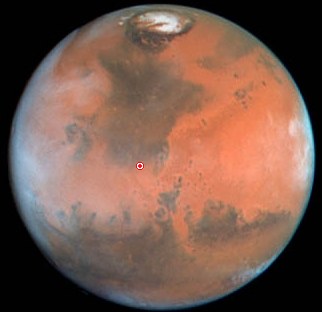


Editorial









Editorial
Space research is necessary, and participation in an internationally cooperative manned space program to support research and development of beneficial space-based science and commercial endeavors is a legitimate national priority. Bush’s $16 billion-per-year program to return to the Moon, just beginning to sink into what will no doubt become over-run spending, has no priority or benefit, other than the chance that a rare element for power production might be found and exploitable there, according to an expert quoted in the New York Times. It will also mean billions to Bush’s industrial base, but there are more legitimate challenges for spending to benefit that sector’s growth. Government investment in technology and science must focus on understanding the environment and its systems, to better prepare for, avert, and sustain recovery from the devastation that, as an unavoidable part of its dynamic, cannot be averted.Named after the ancient Roman God of War, Mars has been at the burning core of mankind's speculation and fear about life in the Universe since the first telescope powerful enough to discern its polar ice caps was pointed at it in the night sky. A century past, and Percival Lowell looked beyond the astonishing implications of the polar caps and the fascination of Mars' warm, reddish color, and from observations made with his new observatory, he perceived canals. The succession of increasingly more-refined pictures of our sister planet had fueled the belief that life, even intelligent life, threatening life, peered back across the blackness of space at us...As the money begins to flow, more news about the program comes to attention, but very little of it addresses any benefit of such a costly outlay of limited resources. Why is that? Could it be because there really is no benefit, aside from those who get the contracts and those who deliver them? Two decades or so ago, I was a guest in the Key Largo, Florida home of former Apollo 8 astronaut, Frank Borman, and he emphatically said to me, “We’ll never go back to the Moon. It’s too expensive and there’s no reason to go.” What’s changed? Solid reasons and benefits should be ahead of the commitment and spending, not a possible, wishful, or Bush-contrived postscript to them.
Every industrial segment Bush targets for the tilt of the federal purse is another misplaced priority. The fantasy $230 billion for the new Moon project will begin to mushroom into a reality that will be astronomically far beyond that, beginning with Lockheed Martin’s development of the Apollo-like Orion. Meanwhile, astronomers and “anti-collision” engineering researchers, operating under a tiny trickle of the money shower primed to fall on Lockheed, have only found an estimated half of the large asteroid bodies that can wipe out or seriously reduce civilization as we know it, and they have nothing in the pipeline to deal with the threat. And, suddenly perturbed, fast-moving comets can’t even be found to be tracked, long-term. They just show up, and the means to deal with them must be at hand for a relatively quick response. Now, and in the foreseeable future, when a comet or asteroid is found heading Earth’s way, there will be nothing that can be done to stop it, given the current funding and planning. We are laid open and totally unprepared, with the only option to be an announcement that emergency steps are underway that may be able to, or might prevent, or should do this or that, or “the government will do all that can possibly be done, etc.” It will be a frantic scramble with a hopeful, yet dubious outcome. Or worse, there will be no time for a scramble, except into a hole in the ground for all the good that’ll do.
While it is true that co-ed astronauts on Mars and the Moon may be an excuse as insurance against the complete eradication of the species, that is not the most cost-effective or utilitarian method to apply to a problem which will, someday, face the world’s population. A priority that is in the best interest of the taxpayers, and their children, would designate a major portion of the space budget toward finding and tracking all the threats, and to full-time development and deployment of a reliable system to deal with the multi-faceted danger when it arises, as it one day will. Only after that is done should large-scale spending and effort on manned exploration beyond the ISS and/or off-world colonization be considered. That would be sensible and responsible prioritization, and it would be the kind of level-headed, responsive leadership of which Bush is incapable. His culpable leadership, now touching space science, is only concerned with the targeted industrial funding recipients and the painting of himself in the hues of the past Kennedy success.
until the first satellite flybys hinted at the barren, hostile nature of its actual environment.
On Independence Day, 1997, the genius of American science, engineering and technology established an operational outpost on Mars' ancient, rocky Ares Vallis flood plain, that not only marked the beginning of a new administrative and fiscal approach to planetary study and the search for life on Mars and beyond, but became the pathfinder for an increasingly ambitious string of automated invaders for the next decade.
After almost three months of exploration, on September 27, 1997 the Pathfinder spacecraft went silent and the mission was declared officially completed... and successful, to a point far beyond the most ambitious hopes of project scientists. The information returned on atmospherics, magnetics, soil and rock analysis, and the pictures, will all be studied for the next several years.
We celebrated the bi-centennial, Roswell UFO anniversary by turning the tables on those who would think of the Human Race as a backward civilization that waits to be either conquered or enlightened by extraterrestrials who, in their presumed superiority, are assumed to have achieved advanced, technological miracles we cannot hope to equal. And, this is only the beginning. Before the year 2012, NASA is hoping to achieve a return of geological samples to Earth, and beyond that, to achieve a manned landing that will ultimately place up to six scientist explorers on the Martian surface for 18 months, and to be successful, many life-support, system engineering, resource development and physiological problems are being addressed that must be resolved.
Progress on the subsequent Mars missions, which will be planned based on evaluations of Pathfinder's discoveries, Global-Surveyor data still being retrieved, and data from the landers and orbiters planned for the next two decades, will be reported on this page as circumstances permit.


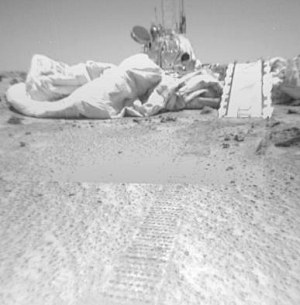

At the very top of the page is the Hubble Space Telescope global image of Mars, taken in the March 2001 opposition, highlighting the North Pole. The red marker overlayed onto it is Pathfinder's landing site. Below is the remarkable Mars global view highlighting the South Pole, also provided by the Hubble Space Telescope, this one in the August 2003 opposition, when Mars was the closest to Earth that it had been for the past 60,000 years, some 34.6 million miles.

The photographs on this site are courtesy of NASA/JPL/Caltech/Malin Space Science Systems. Sojourner ®, Mars Rover ® and spacecraft design and images copyright © 1996-1997 California Institute of Technology - All rights reserved. Further reproduction prohibited without accompanying copyright notice.

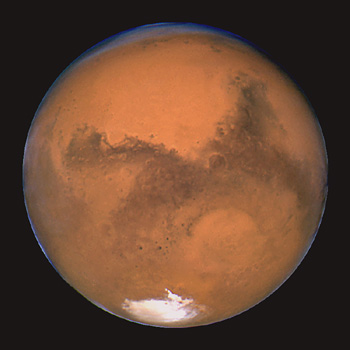




Water, Fertile Soil, and Meteors... Life will find a way?
Aside from the Phoenix lander’s landmark discovery of water ice and soil nutrients abundant enough for microbe or plant life, other major items topping the news on Martian discoveries over the last several years include: a comparison of 2004-2005 survey photos taken from orbit proves that subsurface water does exist, irregularly erupting to flow down gullies. The same photo comparisons also reveal that the surface is absorbing meteor impacts, leaving craters in such numbers that it could be hazardous for any surface-colonization environments. The Martian atmosphere, being much thinner than Earth’s, allows many meteors to get through to the surface which, entering Earth’s atmosphere, would burn up before striking to form cratering.


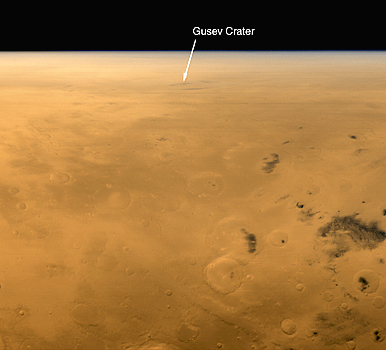
At the same time that the Mars Global Surveyor (MGS) was receiving data during Spirit's landing, the MGS MOC obtained this oblique wide-angle view (above), looking east across the Martian surface toward Gusev Crater, the site where the MER-A landed. The image is labeled to show the location of Gusev Crater, the arrow pointing approximately to the Spirit touched-down spot. The Gusev Crater (165-km/103-mi diameter) and the Spirit landing site are located near 14.70°S, 184.60°W.


A mosaic of Spirit's first images, returned after a safe drop-and-bounce landing, only days after European Space Agency Mars loss. Image above, the first group mosaic, is linked to JPL Mars Rover home page. Below, the first color image, returned January 6, 2004; and below that, a closeup, at JPL resolution, of the first color image.
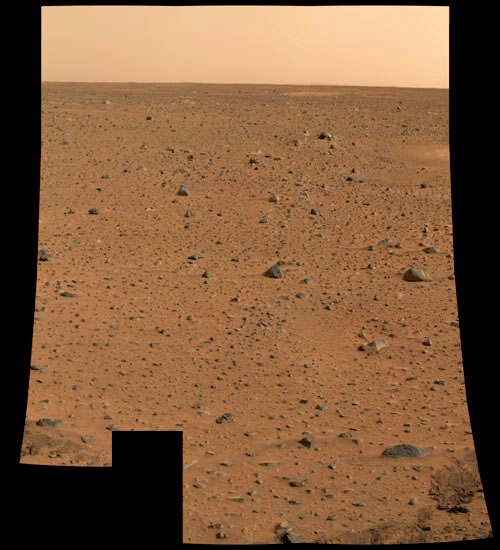

NASA "Scout" selections will affect long-term priorities
NASA outlines plan for two decades of exploration
Sediments are significant discovery
The next visitor to the planet, Surveyor 2001, launched on a Delta II rocket from Cape Canaveral on April 7, 2001, at 11:02 a.m., and on May 23 was 14.3 million kilometers (8.9 million miles) from Earth, traveling at a speed of about 29 kilometers per second (about 65,700 miles per hour) relative to the Sun, and on time to enter Martian orbit on October 24. NASA has dubbed the mission 2001 Mars Odyssey in recognition of the Arthur C. Clarke Novel/Stanley Kubric movie 2001 - A Space Odyssey, and the expectations that they excited for the future of space travel and exploration.A successful, 82-second, en-route trajectory-correction burn used minimal fuel, which will allow JPL to devote more fuel to orbital mission trajectories and provide greater mission flexibility.
After a perfectly executed and on-time arrival, Odyssey will remain in the arrival-navigation phase until a circular orbit is attained by aero-braking and the science mission can begin, which is now forecast for early February.
Odyssey carries three instruments for carrying out critical mission objectives: an emission imaging system (THEMIS), a gamma ray spectrometer (GRS), and the Mars Radiation Environment Experiment (MARIE). The primary objectives are to determine the nature of any radiation hazard to astraunauts, gain insights into Martian geological characteristics and processes, and to identify minerals and measure hydrogen to interpolate theories on the possible presence of water.
2003 In light of the 1999 mission losses, NASA implemented new management and mission procedures and re-evaluated the exploration options for the Year-2003 Mars-Earth-opposition launch opportunity, when in August, Mars will be the closest to Earth (34.6 million miles - 55.7 mkm) that it has been in 5000 years. The many missions under review were cut down to two rovers which will revert back to the airbag-landing concept that was successful with the Pathfinder. Arrival on the Martian surface, probably a dried lake bed or other area where water is believed to have once existed, is scheduled for January 2004.
The planned rovers would not be like Pathfinder, although they will use the same "bouncing ball" landing technology. Instead of a lander-type base station and a small, distance-limited rover, the 2004 rovers will be larger and contain the entire mission package, leaving behind only the deflated landing apparatus as they go on to explore a the largest range of the Martian surface that has ever been attempted.
2005 On October 26, 2000, NASA clearly placed Mars exploration front and center in its beyond-orbit mission planning for the next decade and beyond. Following the previously announced 2001 Mars Odyssey orbiter mission and the twin Mars Exploration Rovers in 2003, NASA announced that it will send a high resolution scientific orbiter, dubbed the Mars Reconnaissance Orbiter (MRO), to the planet in 2005. Its mission will focus on leads suggesting water that have been and are being gleaned from the MGS images. The MRO will provide scientists with 20-to-30-centimeters (8-to-12-inch) resolution, powerful enough to resolve the office water-cooler bottle.
NASA has named a project manager for the Mars Reconnaissance Orbiter mission, which is proposed for launch in August 2005. The mission will seek to identify evidence of water, will provide high resolution imagery (to two feet) for science study and to locate prospective landing sites for future missions, and it will provide a communications link for future missions.
A new category of small "Scout" missions, which could involve airborne vehicles or small landers, was also announced, the first of which is planned for 2007, and the objectives of which are to be based upon science community proposals. These small missions are attractive because they provide the potential to increase observational perspectives and the number of investigative targets. On June 14, 2001, the ten most promising Mars "Scout" mission concepts, of 43 submitted to NASA for possible launch to Mars in 2007, were selected to receive up to $150,000 funding, each, for six months of further study.
2007
In this writer's mind, the basic science of initial discovery on Mars is being completed, and despite the perceived advantage of Scout mission perspectives and targets, Mars exploration should now be moving to a new level, based upon several assumptions that must come under consideration for any mission planning. First, assume the objective is to establish permanent colonies on Mars for the purpose of exploiting its resources and expanding human civilization as broadly as technology and planet resources will allow. The reasons for announcing such a goal (as Kennedy announced that the purpose of lunar exploration was to achieve a landing) are significant:
The cost of accomplishing this will be so enormous that it would be foolish and wasteful to spend for missions that do not directly support this goal by providing goal-related technology or habitation and site selection data, in lieu of those that seek to achieve long-term data of secondary importance which will be obtained more easily and cheaply, as a matter of course, once permanent stations are established. And, special attention will have to be paid to the selection of the site that will be ground zero for expansion. It will have to be stable terrain, not subject to the most excessive extremes of climate and geology, and it will have to be near water. Missions now should be selected with the objective of finding the site best suited to meeting those requirements, rather than a less-focused, wide-area, multi-landing program, which will equally spread resources away from the objective and add to the time-line for the first manned landing, rather than help to meet or compress it. The first priority now should be to search for, find, and confirm a water source suitable to the needs of colonization, and then use the available resources to determine that the location meets other requirements. We should know the landing site better than we knew the Sea of Tranquility, and that requires a focused, closing-in approach, not a continuing planetary dispersal of instrumentation.
- an independent colony on Mars negates the threat to mankind of the doomsday asteroid, war, or pandemic.
- it increasingly justifies the expense of all exploration, and
- it advances technology.
Based upon these assumptions and criteria, of the ten proposals approved by NASA for further study, this writer believes only the following three should be considered for the future or funded now and that these types of missions, to search for water and map surface strata geology, should be carried out over every area that is believed to be suitable for the first station site until a suitable water source is found:
The other proposals announced were:
- The Naiades: Dr. Bob Grimm, Blackhawk GeoServices, Golden, Colo. Four landers would explore for subsurface liquid water using a novel low-frequency sounding method.
- Mars Scout Radar: Dr. Bruce Campbell, Smithsonian Institution's National Air and Space Museum, Washington, D.C. An orbiter mission would use synthetic aperture radar imaging to map the surface geomorphology and very shallow subsurface (three to five meters deep, or about 10 to 16 feet), to detect buried water channels and other features.
- Artemis: Dr. David Paige, University of California, Los Angeles. Three small landers and micro-rovers on the Martian surface, with two directed to the polar regions, would explore the surface and shallow subsurface for water, organic materials and climate. [This proposal would be acceptable to the long-term goal only if the landing sites are believed as possibly suitable as future station sites.]
NASA has also announced that a mission to return samples to Earth will be preceded by the launch of a long-duration, mobile science laboratory, hopefully as early as 2007, which will provide a new level of surface measurement refinement and confirm high-accuracy, hazard-avoidance landing technology, which is a vital component for sample-return missions and future manned landings.
- Pascal: Dr. Rob Haberle, NASA's Ames Research Center, Moffett Field, Calif. A network of 24 weather stations on the Martian surface would provide more than two years of continuous monitoring of humidity, pressure and temperature and other measurements. [One of these should be placed only at prospective station sites with confirmed water in order to begin a record of the local environment and confirm the expected climatology.]
- Urey: Dr. Jeff Plescia, U.S. Geological Survey, Flagstaff, Ariz. A surface rover would allow the absolute ages of geological materials to be remotely determined for the first time on any planet. [Geological archaeology can wait for the station geologist.]
- CryoScout: Dr. Frank Carsey, JPL. This mission, designed to use heated water jets to descend through martian polar ice caps, could potentially probe to depths of tens to hundreds of meters, or yards, while measuring composition and searching for organic compounds. [It may be that the fringes of the polar regions are the only sites where suitable water for colonization is found, and if so, this investigation would be more effective and far less costly if done by a station team, and unless it is capable of finding something that would bear on a decision to go there, or not, it can wait until then.]
- Sample Collection for Investigation of Mars: Dr. Laurie Leshin, Arizona State University, Tempe. This innovative mission would sample atmospheric dust and gas using aerogel and use a "free-return trajectory" to bring the samples back to Earth. [Since analysis of this type can be conducted remotely with findings radioed back to Earth, or wait for manned landing and permanent station, why go to the trouble and the risk? The answers provided won't affect the knowledge base related to suitability for colonization.]
- KittyHawk: Dr. Wendy Calvin, University of Nevada, Reno. A mission involving three gliders would explore the composition and stratigraphy of the walls of Valles Marineris in ways not possible for orbiters and landers. [More geologic archaeology, but very tricky, requiring delicate parts and AI robotics.]
- Mars Environmental Observer: Dr. Michael Janssen, JPL. This science orbiter would intensively explore the role of water, dust, ice and other materials within the Martian atmosphere to understand parts of the hydrologic cycle. [Do we understand the hydrologic cycle of Earth? If we did, could we significantly improve storm forcasting and warning? That seems a higher priority for the resources, especially since dust devils and sparse lightening seem to be the major Martian phenomena, except that resources shouldn't be diverted from Man-on-Mars objectives.]
- Mars Atmospheric Constellation Observatory: Dr. Robert Kursinski, University of Arizona, Tucson. A network of micro-satellites as a constellation around Mars would characterize the 3-D structure of the atmosphere, giving a new look at Martian climatology. [See MEO answer above. The look seen from the station would be preferable, and this investigation won't be a factor in the cost or science of getting there.]
The next decade will see more orbiters, landers, and rovers, and will be highlighted by the ;first missions to return samples to Earth, now being planned for 2014 and 2016. "Launch pportunities" are defined by NASA as periods of advantageous alignment between Earth and Mars which minimize the fuel needed to complete the trip. Missions can be launched every 26 months during these periods, and alternatives that will permit accelerated exploration timetables and move the first sample-return mission to 2011 are being studied.
2010
Opposition to the return of samples has been voiced by the International Committee Against Mars Sample Return (ICAMSR), a group of scientists and active amateurs, which warns that microbes within the samples could unleash an uncontrollable, deadly plague upon various species of life on Earth, including man. They cite the mass extinctions in Earth's past, including the dinosaurs' demise of 65 million years ago, noting that it took 2.5 million years after the impact for them to vanish, and that viruses may have likely played a role in their extinction and others. ICAMSR also warns that current technology is not capable of safely handling the samples, but most scientists are not concerned with the risk and are satisfied that NASA's plans to isolate the samples will provide more than adequate safeguards against any organism that may be returned with the samples.
The second decade will also see development of advanced technology in areas of science-instrument miniaturization and drilling to several hundred feet.
International participation, primarily from Italy and France, is expected to take the form of collateral missions, shared communications and launch resources, and in the development of sample collection and return systems.
NASA scientist David Morrison said in 1999 that a manned mission to Mars could be launched as early as 2008, but this is now an outdated expectation. In light of the 1999 setbacks and NASA's announced plans for the next two decades, and more important, NASA's decision not to address a manned landing schedule, it is premature to make any kind of informed estimate on a manned mission, but a revised guesstimate would be more like 2024, assuming only minor setbacks in NASA's new planning. This guesstimate addresses a more interesting question about the first manned mission--the operational aspect it will follow. Because of the costs, the travel time, and the inability to realize scientific advantage from a manned orbital mission over unmanned platforms, the first manned mission is not likely to be orbital. Nor will it follow the same "near-landing" profile that was employed by Apollo missions prior to the Apollo 11 Moon landing. The first manned mission will go for the landing, and that commitment will require more extensive preparation and development."We have developed a campaign to explore Mars unparalleled in the history of space exploration. It will change and adapt over time in response to what we find with each mission. We will establish a sustained presence in orbit around Mars and on the surface with long-duration exploration of some of the most scientifically promising and intriguing places on the planet."Scott Hubbard
Mars Program Director
NASA Headquarters, Washington, D.C.



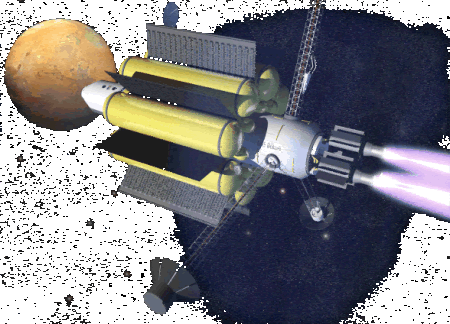
Artist's concept of the ASPL Magnetoplasma Rocket

A new method of propulsion for manned space travel that would cut the transit time to Mars from ten months to four is being developed in association with NASA by Advanced Space Propulsion Laboratory (ASPL). ASPL's Magnetoplasma design is important because reduced travel time means reduced exposure to radiation and weightlessness for the astronauts, which is a key concern for a ten-month-long, conventional, chemical-propellant powered trip.







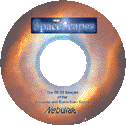

Text is Copyright © Silkscape Arts - All rights reserved

You are explorer number to go in advance of the Martian colonization.


You'll need the
 player to view and manipulate
player to view and manipulate
VRML MOV files on the Ares Vallis NASA site link, so get it!



